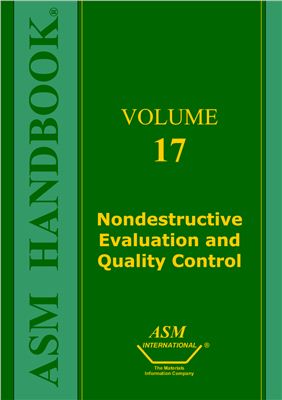ASM Inteational, 2002, 1608 p.
Volume 17 of Metals Handbook is a testament to the growing importance and increased sophistication of methods used to nondestructively test and analyze engineered products and assemblies. For only through a thorough understanding of mode techniques for nondestructive evaluation and statistical analysis can product reliability and quality control be achieved and maintained.
Volume 17 is divided into five major sections. The first contains four articles that describe equipment and techniques used for qualitative part inspection. Methods for both defect recognition (visual inspection and machine vision systems) and dimensional measurements (laser inspection and coordinate measuring machines) are described.
In the second section, 24 articles describe the principles of a wide variety of nondestructive techniques and their application to quality evaluation of metallic, composite, and electronic components. In addition to detailed coverage of more commonly used methods (such as magnetic particle inspection, radiographic inspection, and ultrasonic inspection), newly developed methods (such as computed tomography, acoustic microscopy, and speckle metrology) are introduced. The latest developments in digital image enhancement are also reviewed. Finally, a special six-page color section illustrates the utility of color-enhanced images.
The third section discusses the application of nondestructive methods to specific product types, such as one-piece products (castings, forgings, and powder metallurgy parts) and assemblies that have been welded, soldered, or joined with adhesives. Of particular interest is a series of reference radiographs presented in the article "Weldments, Brazed Assemblies, and Soldered Joints" that show a wide variety of weld discontinuities and how they appear as radiographic images.
The reliability of discontinuity detection by nondestructive methods, referred to as quantitative NDE, is the subject of the fourth section. Following an introduction to this rapidly maturing discipline, four articles present specific guidelines to help the investigator determine the critical discontinuity size that will cause failure, how long a structure containing a discontinuity can be operated safely in service, how a structure can be designed to prevent catastrophic failure, and what inspections must be performed in order to prevent failure.
The final section provides an extensive review of the statistical methods being used increasingly for design and quality control of manufactured products. The concepts of statistical process control, control charts, and design of experiments are presented in sufficient detail to enable the reader to appreciate the importance of statistical analysis and to organize and put into operation a system for ensuring that quality objectives are met on a consistent basis.
Volume 17 of Metals Handbook is a testament to the growing importance and increased sophistication of methods used to nondestructively test and analyze engineered products and assemblies. For only through a thorough understanding of mode techniques for nondestructive evaluation and statistical analysis can product reliability and quality control be achieved and maintained.
Volume 17 is divided into five major sections. The first contains four articles that describe equipment and techniques used for qualitative part inspection. Methods for both defect recognition (visual inspection and machine vision systems) and dimensional measurements (laser inspection and coordinate measuring machines) are described.
In the second section, 24 articles describe the principles of a wide variety of nondestructive techniques and their application to quality evaluation of metallic, composite, and electronic components. In addition to detailed coverage of more commonly used methods (such as magnetic particle inspection, radiographic inspection, and ultrasonic inspection), newly developed methods (such as computed tomography, acoustic microscopy, and speckle metrology) are introduced. The latest developments in digital image enhancement are also reviewed. Finally, a special six-page color section illustrates the utility of color-enhanced images.
The third section discusses the application of nondestructive methods to specific product types, such as one-piece products (castings, forgings, and powder metallurgy parts) and assemblies that have been welded, soldered, or joined with adhesives. Of particular interest is a series of reference radiographs presented in the article "Weldments, Brazed Assemblies, and Soldered Joints" that show a wide variety of weld discontinuities and how they appear as radiographic images.
The reliability of discontinuity detection by nondestructive methods, referred to as quantitative NDE, is the subject of the fourth section. Following an introduction to this rapidly maturing discipline, four articles present specific guidelines to help the investigator determine the critical discontinuity size that will cause failure, how long a structure containing a discontinuity can be operated safely in service, how a structure can be designed to prevent catastrophic failure, and what inspections must be performed in order to prevent failure.
The final section provides an extensive review of the statistical methods being used increasingly for design and quality control of manufactured products. The concepts of statistical process control, control charts, and design of experiments are presented in sufficient detail to enable the reader to appreciate the importance of statistical analysis and to organize and put into operation a system for ensuring that quality objectives are met on a consistent basis.

